Conjured from the ruins of the empire of Austria-Hungary in
the wake of the Great War, Czechoslovakia worked throughout the 1920s to
establish itself as a center of democracy, culture, and technological
progress for central Europe. This resulted in the works of Franz Kafka, Rossum's
Universal Robots, and a vibrant avant-garde community. Plus a
short-lived but very productive aviation industry which produced this
neat little biplane fighter.
 The Avia B.534 was the last in a long succession of high-performance
biplanes and was the contemporary of the Gloster Gladiator, Fiat CR.42,
and Polikarpov I-15 family. In a bid to increase foreign sales, the Avia
put in a good showing at 1937 Zurich international air meeting,
reportedly coming in second only to the newer monoplane Bf-109.
The Avia B.534 was the last in a long succession of high-performance
biplanes and was the contemporary of the Gloster Gladiator, Fiat CR.42,
and Polikarpov I-15 family. In a bid to increase foreign sales, the Avia
put in a good showing at 1937 Zurich international air meeting,
reportedly coming in second only to the newer monoplane Bf-109.
The Czechs were also the first to recognize the value of
aircraft in law enforcement when a distinguished detective by the name
of Zdeněk Bubník was forced to watch in frustration as a serial killer
suspect fled by train across the open countryside to Bratislava. After
some bureaucratic wrestling and a poor early start with obsolete types a
dozen Avias were released from the production lines for this new
service, the Czech Air Police, which was supposed to prevent such
escapes from occurring again. However, this mission quickly began to
change focus as a new problem appeared: foreign reconnaissance aircraft
intruding Czech airspace assessing the land for future conquest. The axe
was about to fall. In 1938 the international community fed the young
nation to its ambitious neighbors with Nazi Germany seizing the key
industrial areas and the Avia plant. Many of the 500-odd 534s built were
distributed to Germany's allies and its own training units, with some
being retained by the treaty-compliant Slovak Air Force.
 The Avia finally saw action with its original user (in some guise,
anyway) during one of the forgotten early-war border skirmishes when
neighboring Hungary grabbed some of the southern Slovakian districts in
the early months of 1939, the Slovaks losing several Avias to Hungarian
Fiat CR.32s. Later that year, Slovakia sent a couple of squadrons to
support the German invasion of Poland, the Avias downing a single Polish
reconnaissance aircraft for the loss of two more aircraft to triple-A.
Those same squadrons were also sent in support of operation Barbarossa,
but were weakened by the continual loss of personnel attending to the
autumn harvest and morale bad enough that a few dozen pilots deserted in
their Avias to Soviet lines as the war dragged on. The type really spent
most of its time in service as a fighter trainer and in anti-partisan
duty. In short, it really didn't distinguish itself in combat owing to
the times and circumstances in which it was deployed. Except for one
event: in September 1944 an Avia being flown by a rebelling Slovakian
pilot chased down and destroyed a fleeing Hungarian Ju-52, scoring the
last known air-to-air kill for a biplane in history.
The Avia finally saw action with its original user (in some guise,
anyway) during one of the forgotten early-war border skirmishes when
neighboring Hungary grabbed some of the southern Slovakian districts in
the early months of 1939, the Slovaks losing several Avias to Hungarian
Fiat CR.32s. Later that year, Slovakia sent a couple of squadrons to
support the German invasion of Poland, the Avias downing a single Polish
reconnaissance aircraft for the loss of two more aircraft to triple-A.
Those same squadrons were also sent in support of operation Barbarossa,
but were weakened by the continual loss of personnel attending to the
autumn harvest and morale bad enough that a few dozen pilots deserted in
their Avias to Soviet lines as the war dragged on. The type really spent
most of its time in service as a fighter trainer and in anti-partisan
duty. In short, it really didn't distinguish itself in combat owing to
the times and circumstances in which it was deployed. Except for one
event: in September 1944 an Avia being flown by a rebelling Slovakian
pilot chased down and destroyed a fleeing Hungarian Ju-52, scoring the
last known air-to-air kill for a biplane in history.
Despite what intuition would lead you to believe, the
bubble-top examples were not some late advanced version; they were
simply various early-series aircraft fitted with canopies on an
individual basis at the depot level.
The trim Avia has always been one of my favorite biplanes, and
it must mean a lot to the Czech people, too, because there have been
several kits of this type in 1/72 originating in this region. The oldest
and most familiar is of course the old KP kit from 1971, resident in
most of our stashes and slightly underscale at about 1/75. More recently
RS Models released a limited-run series of various 534 sub-types with an
available range of photoetch upgrades from Brengun, preceded a little
earlier than that by a similarly comprehensive resin range from HR
models.
Eduard released this one 2014, and--true to form--followed it
with a wide range of version and marking options, aftermarket both
separate and in their Profipack releases, and a Vegas-buffet "Quattro
Combo" with four complete kits, dozens of marking options, and a variety
of extra goodies.
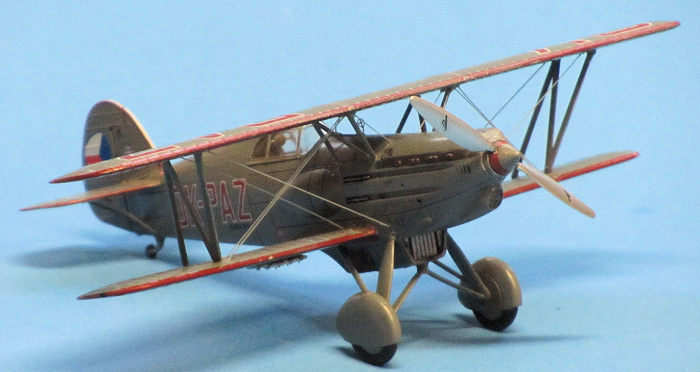 In this release, three dark grey spues cover wing, fuselage, and small
parts; a clear sprue with every canopy and windshield option for the
type, a small color photoetched fret, and a masking sheet (covering not
only the canopy but some of the trickier paint scheme elements) round
out the package. A full-color instruction booklet instruct assembly,
masking, rigging, and four-views of each of the six painting schemes
which outline the type's service history pretty well from the Czech Air
Police from 1937 to the Slovak National Uprising in 1944. Everything
contained is to the very highest quality offered by the industry.
In this release, three dark grey spues cover wing, fuselage, and small
parts; a clear sprue with every canopy and windshield option for the
type, a small color photoetched fret, and a masking sheet (covering not
only the canopy but some of the trickier paint scheme elements) round
out the package. A full-color instruction booklet instruct assembly,
masking, rigging, and four-views of each of the six painting schemes
which outline the type's service history pretty well from the Czech Air
Police from 1937 to the Slovak National Uprising in 1944. Everything
contained is to the very highest quality offered by the industry.
One of the main differences between each of these releases is
the fuselage sprue: Eduard took the time to cut at least five different
ones to depict the open cockpit, closed cockpit, different gun slot
arrangement of the Bk-, the bubble-canopy, and the streamlined racer.
The bubbletop version was only ever offered in the Quattro combo and as
an Overtrees release as far as I've seen.
Also, some time after I purchased this kit (and after it had
been out for several years) I noticed Eduard offering a "Wings Upgraded"
sprue under their Overtrees aegis for $6 US. Curious, I ordered a set.
Upon arrival, these 'upgrades' consist of 1) much more foolproof and
secure wing strut mountings, 2) more restrained surface detail, and 3)
wingtip position lights.
The addition of this purchase combined with the kit's options
left me with a lot of extras! These included wheels, a propeller, and a
complete set of flying surfaces, among other useful bits. I gazed at the
unused parts, and the KP kit nearby that would now never be built. The
creative gears started turning...
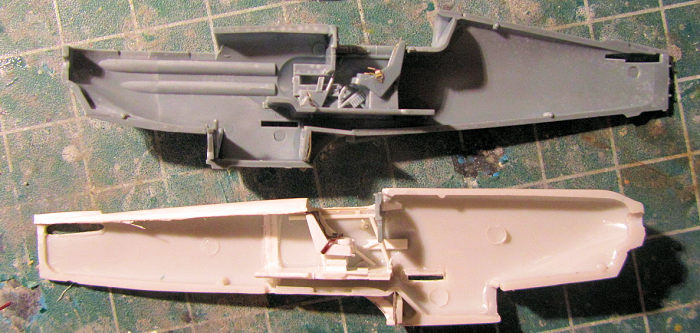 Soon
I was busy modifying the KP fuselage and landing gear to take the
redundant Eduard parts and converting it to the low-back/bubble canopy
configuration. This ended up being a pretty involved effort, as I not
only had to stretch the fuselage to 1/72 with a plug aft of the cockpit
and cut down the rear fuselage upper decking and shape a new one from
styrene laminate, but build up new wing roots, lengthen and reshape the
radiator housing, sand it all down and rescribe, and scratchbuild a new
cockpit to match Eduard's stock example...which I was building and
painting in parallel.
Soon
I was busy modifying the KP fuselage and landing gear to take the
redundant Eduard parts and converting it to the low-back/bubble canopy
configuration. This ended up being a pretty involved effort, as I not
only had to stretch the fuselage to 1/72 with a plug aft of the cockpit
and cut down the rear fuselage upper decking and shape a new one from
styrene laminate, but build up new wing roots, lengthen and reshape the
radiator housing, sand it all down and rescribe, and scratchbuild a new
cockpit to match Eduard's stock example...which I was building and
painting in parallel.
I took the time to mark and drill all the holes for the
rigging next. It's less fun doing so when the model is assembled,
especially in 1/72!
The cockpits and KP fuselage complete, construction proper
began. For the stock Eduard model, this was done over the course of a
single day as I worked on some overdue housecleaning, stopping by the
bench and spending five minutes assembling the fuselage and upper cowl
parts, visiting a little later for ten minutes to clean all the seams (I
used Tenax/Micromark 'Same Stuff', so all the joints were ready for
cleanup wit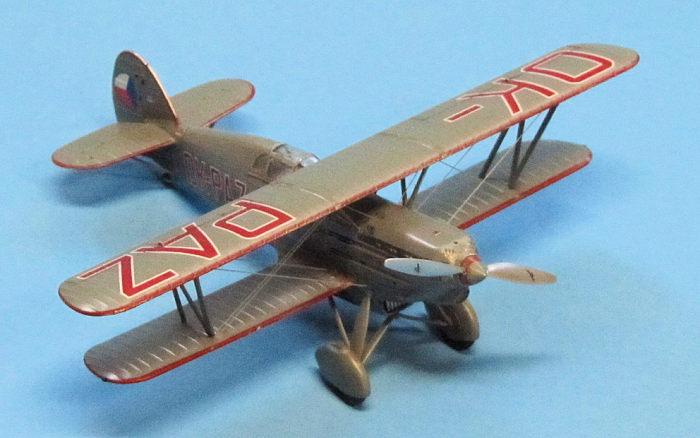 hin
the hour) and apply the canopy mask, still later for another ten
assembling the landing gear, and so on, until after half a dozen
sessions totaling less than forty-five minutes I had the whole thing
together with struts, less the top wing.
hin
the hour) and apply the canopy mask, still later for another ten
assembling the landing gear, and so on, until after half a dozen
sessions totaling less than forty-five minutes I had the whole thing
together with struts, less the top wing.
The ersatz bubble-top model naturally took a little longer,
as I had to continue adapting parts to some degree and one set of
cabanes went sailing out of my tweezers and arcing into the unknown,
requiring replication from styrene strip. But even this second model
only took a couple of hours after I had converted the fuselage to get it
ready for primer.
Whenever I build a biplane, I attach all the struts to the
bottom wings and fuselage just before painting with the top wing dry
fitted temporarily to assure alignment. The pain of working around these
during the finishing process is worth it for the fact that it restricts
the mess of gluing and touchup to the less-visible bottom surface of the
upper wing.
All along I wanted to do the Czech Air Police version with its snazzy
red-trim-over-green/grey scheme. Eduard suggests Gunze "Hemp" to achieve
the odd basic hue. Not having easy access to this range where I live out
in the sticks, I combined RLM 70 and 02 with a little Testor's Gloss
White to achieve it. My reference photos showed different shades for the
reds of the airframe trim, registration, and national markings so you
needn't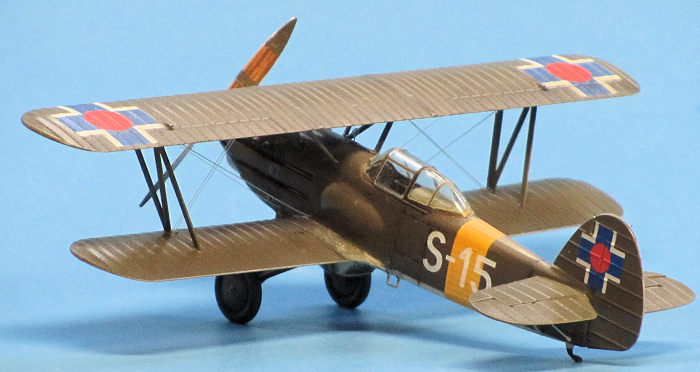 bother matching these. After a gloss coat of Future/XXXX, the decals
went on marvelously, sucking down into the detail with only a light coat
of Micro-Sol. After a light weathering treatment and another clear coat,
and with the model on its back, I very gently placed and aligned a set
of QuickBoost resin empty bomb racks, leaving them to cure while I drove
off for a night at work.
bother matching these. After a gloss coat of Future/XXXX, the decals
went on marvelously, sucking down into the detail with only a light coat
of Micro-Sol. After a light weathering treatment and another clear coat,
and with the model on its back, I very gently placed and aligned a set
of QuickBoost resin empty bomb racks, leaving them to cure while I drove
off for a night at work.
The bubble-top model was built to a wartime scheme and
received a custom 50/50 mix of RAF Dark Green and Testor's Gloss Light
Brown with a bit of white over a coat of lightened RLM 65 Lichtblau.
This matched my references for the green-over-grey of a Slovak machine
pretty well. All decals for this second model were sourced from among
the options of the kit; the fuselage registration numeral modified
slightly.
Painting and weathering done, both models were rigged via the
stretched sprue method.
As one of those whose modelling time has actually been reduced,
not increased, by COVID measures, I've really begun to appreciate a nice
kit that I can assemble with neither delay nor drama. This product has
edged out Tamiya's P-47 as the best kit in 1/72 I have ever had the
pleasure of assembling.
The second model that I stuck together out of all the
'leftovers' was a nice bonus!
Krybus, Josef. The Avia B.534. Profile Publications, Berkshire
UK and Sun Valley, CA 1968(?)
Sumichrast, Peter and And'al, Jozef. Avia B-34, B-534 a Bk-534.
HT model magazin Poprad, Slovakia 1998(?)
Rajlich, Jiri and Sehnal, Jiri. Slovak Airmen 1939-1945. Unknown
publisher, 1991
Ryan Grosswiler
21 September 2021
Copyright ModelingMadness.com. All rights reserved. No reproduction in
part or in whole without express permssion.
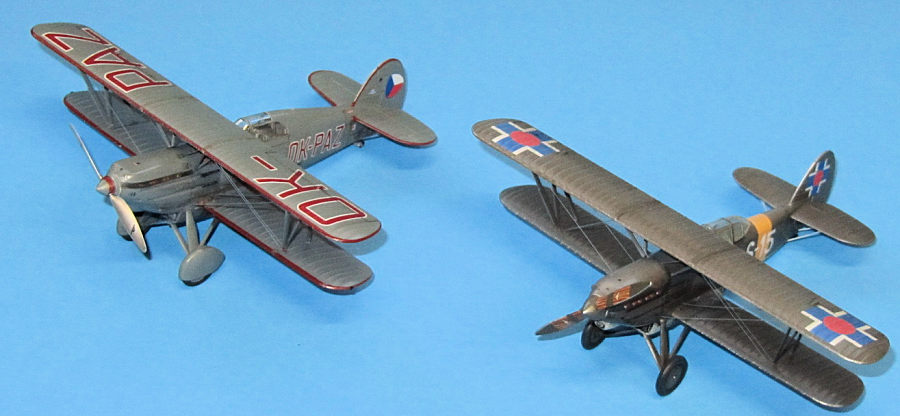

 The Avia B.534 was the last in a long succession of high-performance
biplanes and was the contemporary of the Gloster Gladiator, Fiat CR.42,
and Polikarpov I-15 family. In a bid to increase foreign sales, the Avia
put in a good showing at 1937 Zurich international air meeting,
reportedly coming in second only to the newer monoplane Bf-109.
The Avia B.534 was the last in a long succession of high-performance
biplanes and was the contemporary of the Gloster Gladiator, Fiat CR.42,
and Polikarpov I-15 family. In a bid to increase foreign sales, the Avia
put in a good showing at 1937 Zurich international air meeting,
reportedly coming in second only to the newer monoplane Bf-109. The Avia finally saw action with its original user (in some guise,
anyway) during one of the forgotten early-war border skirmishes when
neighboring Hungary grabbed some of the southern Slovakian districts in
the early months of 1939, the Slovaks losing several Avias to Hungarian
Fiat CR.32s. Later that year, Slovakia sent a couple of squadrons to
support the German invasion of Poland, the Avias downing a single Polish
reconnaissance aircraft for the loss of two more aircraft to triple-A.
Those same squadrons were also sent in support of operation Barbarossa,
but were weakened by the continual loss of personnel attending to the
autumn harvest and morale bad enough that a few dozen pilots deserted in
their Avias to Soviet lines as the war dragged on. The type really spent
most of its time in service as a fighter trainer and in anti-partisan
duty. In short, it really didn't distinguish itself in combat owing to
the times and circumstances in which it was deployed. Except for one
event: in September 1944 an Avia being flown by a rebelling Slovakian
pilot chased down and destroyed a fleeing Hungarian Ju-52, scoring the
last known air-to-air kill for a biplane in history.
The Avia finally saw action with its original user (in some guise,
anyway) during one of the forgotten early-war border skirmishes when
neighboring Hungary grabbed some of the southern Slovakian districts in
the early months of 1939, the Slovaks losing several Avias to Hungarian
Fiat CR.32s. Later that year, Slovakia sent a couple of squadrons to
support the German invasion of Poland, the Avias downing a single Polish
reconnaissance aircraft for the loss of two more aircraft to triple-A.
Those same squadrons were also sent in support of operation Barbarossa,
but were weakened by the continual loss of personnel attending to the
autumn harvest and morale bad enough that a few dozen pilots deserted in
their Avias to Soviet lines as the war dragged on. The type really spent
most of its time in service as a fighter trainer and in anti-partisan
duty. In short, it really didn't distinguish itself in combat owing to
the times and circumstances in which it was deployed. Except for one
event: in September 1944 an Avia being flown by a rebelling Slovakian
pilot chased down and destroyed a fleeing Hungarian Ju-52, scoring the
last known air-to-air kill for a biplane in history. In this release, three dark grey spues cover wing, fuselage, and small
parts; a clear sprue with every canopy and windshield option for the
type, a small color photoetched fret, and a masking sheet (covering not
only the canopy but some of the trickier paint scheme elements) round
out the package. A full-color instruction booklet instruct assembly,
masking, rigging, and four-views of each of the six painting schemes
which outline the type's service history pretty well from the Czech Air
Police from 1937 to the Slovak National Uprising in 1944. Everything
contained is to the very highest quality offered by the industry.
In this release, three dark grey spues cover wing, fuselage, and small
parts; a clear sprue with every canopy and windshield option for the
type, a small color photoetched fret, and a masking sheet (covering not
only the canopy but some of the trickier paint scheme elements) round
out the package. A full-color instruction booklet instruct assembly,
masking, rigging, and four-views of each of the six painting schemes
which outline the type's service history pretty well from the Czech Air
Police from 1937 to the Slovak National Uprising in 1944. Everything
contained is to the very highest quality offered by the industry. Soon
I was busy modifying the KP fuselage and landing gear to take the
redundant Eduard parts and converting it to the low-back/bubble canopy
configuration. This ended up being a pretty involved effort, as I not
only had to stretch the fuselage to 1/72 with a plug aft of the cockpit
and cut down the rear fuselage upper decking and shape a new one from
styrene laminate, but build up new wing roots, lengthen and reshape the
radiator housing, sand it all down and rescribe, and scratchbuild a new
cockpit to match Eduard's stock example...which I was building and
painting in parallel.
Soon
I was busy modifying the KP fuselage and landing gear to take the
redundant Eduard parts and converting it to the low-back/bubble canopy
configuration. This ended up being a pretty involved effort, as I not
only had to stretch the fuselage to 1/72 with a plug aft of the cockpit
and cut down the rear fuselage upper decking and shape a new one from
styrene laminate, but build up new wing roots, lengthen and reshape the
radiator housing, sand it all down and rescribe, and scratchbuild a new
cockpit to match Eduard's stock example...which I was building and
painting in parallel. hin
the hour) and apply the canopy mask, still later for another ten
assembling the landing gear, and so on, until after half a dozen
sessions totaling less than forty-five minutes I had the whole thing
together with struts, less the top wing.
hin
the hour) and apply the canopy mask, still later for another ten
assembling the landing gear, and so on, until after half a dozen
sessions totaling less than forty-five minutes I had the whole thing
together with struts, less the top wing. bother matching these. After a gloss coat of Future/XXXX, the decals
went on marvelously, sucking down into the detail with only a light coat
of Micro-Sol. After a light weathering treatment and another clear coat,
and with the model on its back, I very gently placed and aligned a set
of QuickBoost resin empty bomb racks, leaving them to cure while I drove
off for a night at work.
bother matching these. After a gloss coat of Future/XXXX, the decals
went on marvelously, sucking down into the detail with only a light coat
of Micro-Sol. After a light weathering treatment and another clear coat,
and with the model on its back, I very gently placed and aligned a set
of QuickBoost resin empty bomb racks, leaving them to cure while I drove
off for a night at work.